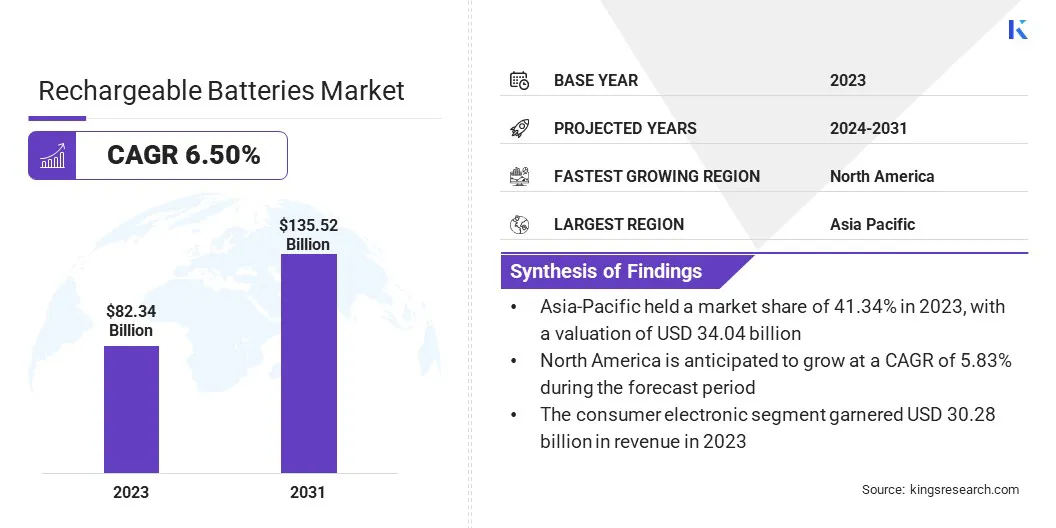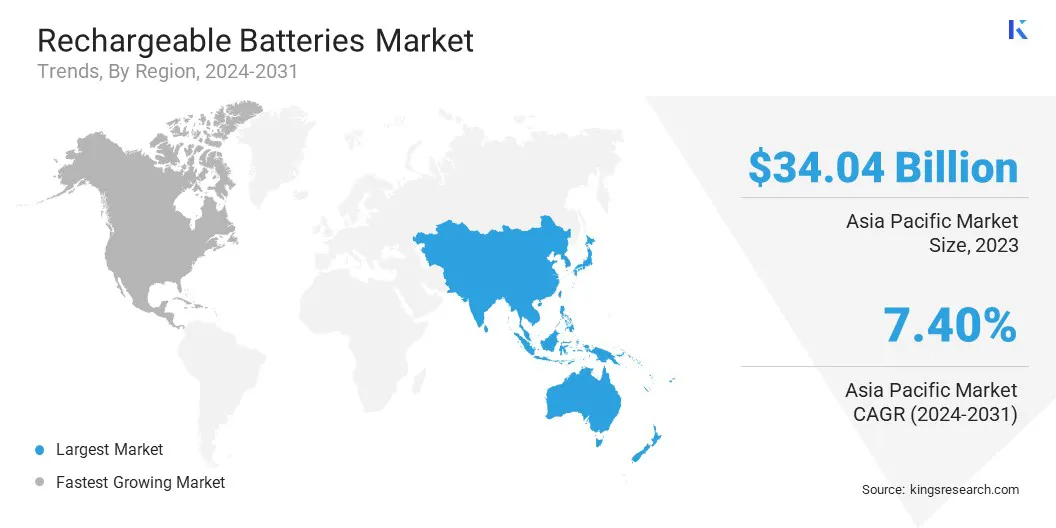Rechargeable Batteries Market Size
The global Rechargeable Batteries Market size was valued at USD 82.34 billion in 2023 and is projected to grow from USD 87.18 billion in 2024 to USD 135.52 billion by 2031, exhibiting a CAGR of 6.50% during the forecast period. The market is expanding rapidly due to increased consumer electronics usage and technological advancements in battery life and charging efficiency.
Growing government incentives for energy storage systems, coupled with the rise of smart devices, are driving demand. Enhanced production capacities and global supply chain developments are further contributing to market growth and fostering innovation.
In the scope of work, the report includes solutions offered by companies such as GP Batteries International Limited., SAMSUNG, Godrej Enterprises Group, Camelion Batterien GmbH, Fedco Batteries, Sony Group Corporation, Spectrum Brands, INC, Energizer, OptimumNano Energy Co., Ltd, Panasonic Corporation, and others.
The rechargeable batteries market is experiencing robust growth, mainly fueled by technological advancements, including the development of solid-state batteries. The rising demand for electric vehicles (EVs) is supporting this growth, as these vehicles require high-capacity batteries for optimal performance and efficiency.
- For instance, in June 2023, Tata Group, India, invested $1.6 billion in an electric vehicle rechargeable battery production plant in Gujarat. This initiative, undertaken in collaboration with the Gujarat state government, aimed to boost the production of electric vehicles and promote sustainability.
Additionally, the integration of batteries with renewable energy systems is supporting energy storage solutions and enhancing grid stability, thereby creating lucrative growth opportunities. Companies are increasingly prioritizing recycling and sustainability efforts to address rising environmental concerns and reduce waste. These factors are collectively propelling market growth by stimulating investment in innovative technologies and scalable production solutions.
Rechargeable batteries are energy storage devices designed for multiple uses. They can be recharged and utilized again once their energy has been depleted. Unlike disposable batteries, which are engineered for single-use, rechargeable batteries can be restored to full charge by using an external power source. They are commonly used in various applications, including consumer electronics, electric vehicles, and renewable energy systems.
Rechargeable batteries are available in various chemistries, such as lithium-ion, nickel-metal hydride, and lead-acid, each offering different performance characteristics. Their ability to be reused makes them a cost-effective and environmentally friendly option, as it reduces waste and lowers overall energy costs.

Analyst’s Review
The rising focus on reducing waste and environmental impact through rechargeable batteries is augmenting market growth. By shifting from disposable to rechargeable solutions, companies are minimizing the accumulation of battery waste and mitigating its environmental footprint. This transition is leading to increased investments in advanced battery technologies, such as next-generation lithium-ion batteries, which propels market expansion.
- For instance, Toyota's USD 853 million funding from the Japanese government for developing new battery technologies underscores its commitment to innovation and sustainability. These investments are enhancing battery performance and fostering the adoption of electric vehicles, thereby supporting sustained market growth and technological advancement.
Key players are expected to strengthen their market presence by investing in cutting-edge rechargeable battery technologies. Forming strategic alliances, including partnerships with government partnerships, and prioritizing sustainability initiatives may further enhance their competitive edge. By leveraging these opportunities, companies are fostering innovation and addressing rising demand.
Rechargeable Batteries Market Growth Factors
The increasing adoption of electric vehicles (EVs) is propelling the growth of the rechargeable batteries market. As the automotive industry shifts toward electric mobility, there is a growing demand for high-capacity batteries to ensure efficient energy storage and optimal vehicle performance.
This trend is driving continuous advancements in rechargeable battery technologies, including improvements in energy density, charging speeds, and overall durability. Battery manufacturers are actively investing in research and development to meet the evolving requirements of the EV sector.
Battery manufacturers are actively engaging in research and development to align with the evolving demands of the EV sector. This is creating a strong demand for advanced battery solutions, thereby stimulating market expansion.
The market faces significant challenges due to volatile raw material prices and environmental concerns associated with material sourcing. These issues hinder market growth by increasing production costs and complicating supply chain management.
Key players are addressing these challenges by investing in alternative materials and recycling technologies to reduce dependence on scarce resources. Additionally, companies are focusing on developing advanced battery technologies that improve efficiency and longevity to reduce environmental impact and mitigate cost fluctuations. Through innovation and strategic sourcing, industry leaders are striving to stabilize supply chains and support sustainable market growth.
Rechargeable Batteries Market Trends
There is a growing trend toward the integration of rechargeable batteries with renewable energy systems, such as solar and wind power. This integration enables the storage of excess energy generated during peak production periods for future use. Rechargeable batteries are effectively aligning intermittent energy generation with consumption, thereby enhancing the reliability and efficiency of renewable energy systems. This advancement is strengthening sustainable energy practices while contributing to grid stability.
- According to the International Energy Agency, by the end of 2022, the total installed grid-scale battery storage capacity approached 28 GW, with the majority of this capacity added in the preceding six years. In 2022 alone, installations surged by over 75% compared to 2021, resulting int the introduction of approximately 11 GW of additional storage capacity.
As energy providers and organizations are investing heavily in these advanced storage solutions, they are advancing their sustainability goals and capitalizing on emerging market opportunities within the rapidly expanding renewable energy storage sector.
The growing focus on solid-state batteries is augmenting the rechargeable batteries market growth by addressing the major limitations of traditional lithium-ion batteries. These advanced batteries offer higher energy densities, which enhances the performance and range of electric vehicles and consumer electronics.
Their improved safety features, such as reduced risk of thermal runaway, are attracting considerable investment. As companies are actively developing and commercializing solid-state technology, they are positioning themselves to capture a substantial share of the market. This innovation is stimulating increased demand for next-generation energy storage solutions, thus fueling market expansion.
Segmentation Analysis
The global market is segmented based on application, battery type, battery size, and geography.
By Application
Based on application, the market is categorized into consumer electronic, electric vehicles, energy storage systems, industrial applications, medical devices, and others. The consumer electronic segment led the rechargeable batteries market in 2023, reaching a valuation of USD 30.28 billion.
The rising demand for portable devices such as smartphones, laptops, tablets, and wearables is generating a substantial demand for high-performance batteries. Innovations in battery technology, including advancements in lithium-ion and solid-state batteries, are addressing surging consumer needs for longer battery life, faster charging, and enhanced safety.
Additionally, the proliferation of smart home devices and IoT applications is contributing to the increased demand for batteries. The growth of the segment is further supported by technological advancements in energy density and miniaturization, enabling more efficient and compact battery solutions for a wide range of consumer electronics. As these trends continue, the consumer electronics segment is poised to witness substantial expansion in the near future.
By Battery Type
Based on battery type, the market is categorized into lithium-ion, lead-acid, nickel-metal hydride, and others. The lithium-ion segment captured the largest rechargeable batteries market share of 55.67% in 2023. The increased use of lithium-ion batteries in electric vehicles (EVs), facilitated by their superior energy density, extended cycle life, and lightweight design, is augmenting segmental growth.
- According to the International Energy Agency, the demand for lithium-ion batteries in the automotive sector increased by approximately 65% in 2022.
Recent advancements in lithium-ion technology, including improved energy efficiency and faster charging capabilities, are fueling segmental growth. As companies continue to innovate and advance these batteries, the segment is experiencing considerable expansion.
This development aligns with the broader trend toward sustainable energy solutions and advanced consumer electronics, thereby fostering segmental growth.
By Battery Size
Based on battery size, the market is categorized into AAA, AA, 18650, and others. The AAA segment is expected to garner the highest revenue of USD 53.22 billion by 2031, mainly spurred by the increased demand for compact and portable power solutions. These batteries are widely used in household devices, including remote controls, cordless phones, and small electronics.
This growth is further fueled by advancements in battery technology, which are enhancing performance, extending battery life, and improving energy efficiency. Additionally, the rising prevalence of consumer electronics and smart home devices is generating a growing demand for reliable AAA rechargeable batteries.
Innovations in energy density and the shift toward more sustainable and eco-friendly products are further supporting the expansion of the AAA battery segment.
Rechargeable Batteries Market Regional Analysis
Based on region, the global market is classified into North America, Europe, Asia-Pacific, MEA, and Latin America.

Asia-Pacific rechargeable batteries market share stood around 41.34% in 2023 in the global market, with a valuation of USD 34.04 billion. The region's expanding consumer electronics industry, coupled with significant investments in electric vehicle (EV) infrastructure and renewable energy, is boosting regional market expansion.
- For instance, the International Energy Agency stated that the demand for batteries for vehicles in China surfed by 70% in 2022.
Government policies that support technological advancements and sustainability are further enhancing growth prospects. As key markets in Asia-Pacific continue to innovate and invest in advanced battery technologies, the region is solidifying its position as a leading market for rechargeable batteries.
North America is anticipated to witness significant growth at a CAGR of 5.83% over the forecast period, mainly attributed to the increasing adoption of electric vehicles (EVs), the expansion of renewable energy, and rising consumer electronics demand. The United States is emerging as the largest market for rechargeable batteries, with notable growth anticipated in Canada.
The North America market benefits from a well-established manufacturing infrastructure, characterized by substantial investments in battery production, which enhances economies of scale and reduces costs. This competitive edge is further bolstered by recent federal initiatives.
- For instance, in October 2022, the U.S. federal government and the Department of Energy announced an allocation of approximately $2.8 billion in funding to stimulate battery material production.
These developments are positioning North America as a key market for rechargeable batteries.
Competitive Landscape
The global rechargeable batteries market report will provide valuable insight with an emphasis on the fragmented nature of the industry. Prominent players are focusing on several key business strategies such as partnerships, mergers and acquisitions, product innovations, and joint ventures to expand their product portfolio and increase their market shares across different regions.
Companies are implementing impactful strategic initiatives, such as expanding services, investing in research and development (R&D), establishing new service delivery centers, and optimizing their service delivery processes, which are likely to create new opportunities for market growth.
List of Key Companies in Rechargeable Batteries Market
- GP Batteries International Limited.
- SAMSUNG
- Godrej Enterprises Group
- Camelion Batterien GmbH
- Fedco Batteries
- Sony Group Corporation
- Spectrum Brands, INC
- Energizer
- OptimumNano Energy Co.,Ltd
- Panasonic Corporation
Key Industry Development
- April 2023 (Product Launch): Xiaomi introduced a multifunctional desk lamp equipped with a rechargeable battery. This portable desk lamp was launched in the China market. Xiaomi’s Mijia, the new model, features a 3-in-2 design and boasts a color rendering index of RA90. The desk lamp includes a 2,000 mAh rechargeable battery and is compatible with a USB Type-C cable.
The global rechargeable batteries market is segmented as:
By Application
- Consumer Electronic
- Electric Vehicles (EVs)
- Energy Storage Systems
- Industrial Applications
- Medical Devices
- Others
By Battery Type
- Lithium-Ion (Li-ion)
- Lead-Acid
- Nickel-Metal Hydride (NiMH)
- Others
By Battery Size
By Region
- North America
- Europe
- France
- U.K.
- Spain
- Germany
- Italy
- Russia
- Rest of Europe
- Asia-Pacific
- China
- Japan
- India
- South Korea
- Rest of Asia-Pacific
- Middle East & Africa
- GCC
- North Africa
- South Africa
- Rest of Middle East & Africa
- Latin America
- Brazil
- Argentina
- Rest of Latin America


